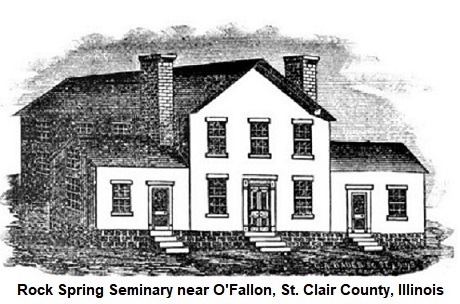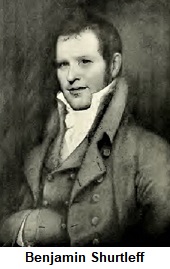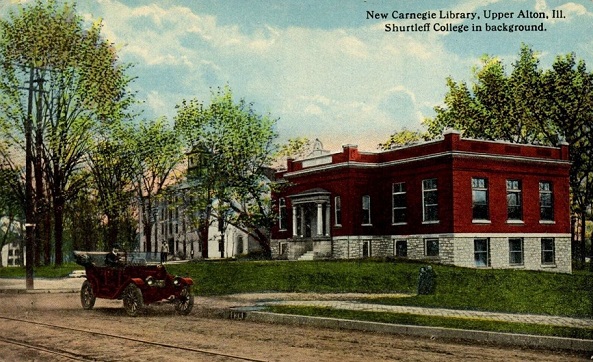Shurtleff College
Faculty | Shurtleff College Newspaper Articles
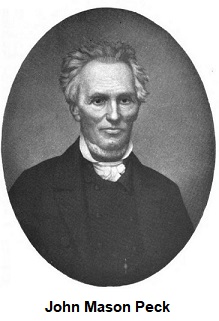
Asa Peck, John’s father, was afflicted with lameness, which placed a
large share of the farm work on John’s young shoulders. From the
time he was fourteen, his summers were devoted to the farm, and in
the winter months, he attended the local common schools. Peck later
stated that the school he attended must have been inferior to
others, as he was more stupid and sluggish than ordinary lads.
Others claimed that while John was uncultivated, he was no
simpleton. At the age of eighteen, on December 15, 1807, he attended
a church meeting, where the work of God’s converting grace brought
John to see himself as a guilty sinner, deserving God’s wrath. By
the end of the week, he converted to Christianity and accepted God’s
grace of salvation.
In 1807, John Peck began to teach school. He soon met Sally Paine, a
native of New York. Sally, whose legal name was Sarah, was an
extraordinary young woman. Her mother had died before she was twelve
years old, and she assumed the housework and charge of three younger
siblings for two years. When her father remarried, she went to
reside with her mother’s parents in Litchfield, Connecticut. There
she met Peck, and they married on May 8, 1809. They lived with his
father and mother about two years, and in 1811 they moved to
Windham, Greene County, New York, near her family’s home. Shortly
after the birth of their first son, they joined the Baptist Church.
Peck taught school, and served as pastor at the Baptist churches in
Catskill and Amenia, New York. He became interested in missionary
work after meeting Luther Rice, and went to Philadelphia to study
under William Staughton. There, Peck met James Ely Welch, a Baptist
minister, who became his missionary partner. The Peck and Welch
families traveled to St. Louis in December 1817. The population of
that “village” was about 3,000, of which one-third were slaves. He
later stated, “One half, at least, of the Anglo-American population
were infidels of a low and indecent grade, and utterly worthless for
any useful purposes of society.”
Peck and Welch organized the First Baptist Church of St. Louis, and
baptized two converts in the Mississippi River in February 1818.
They founded the first missionary society in the West – The United
Society for the Spread of the Gospel. With the missionary support
withdrawn, Peck refused to move back East, and continued his
ministry in St. Louis. Two years later, the Baptist Mission Society
employed Peck at $5 a week. He established Bible societies and
Sunday Schools, and ministered to the rural population. In 1818 he
traveled to Kaskaskia, then the seat of government of Illinois.
In February 1819, Peck felt it was time to establish a seminary for
the common and higher branches of education. It was a goal of his
before leaving the East – to train minds in habits of thinking and
logical reasoning, to educate in the gospel of truth, and to train
in Christian duties. It was deemed necessary to visit several
locations within fifty miles of St. Louis, in which to establish his
seminary. Rufus Easton of St. Louis, who projected the site of
Alton, made Peck promise that he would not locate his planned
seminary until he explored the village known as Upper Alton. On
February 22, 1819, Peck traveled to St. Charles, Missouri, and rode
to the “Missouri Point.” He took Smeltzer’s Ferry across the
Mississippi to Illinois, and traveled eastward to a small settlement
where Alton would later be established. He found four cabins, and
obtained directions on how to find the village of Upper Alton. The
previous year, Peck had met Doctor Erastus Brown, who had moved to
Upper Alton, and planned to make a visit to him there. Emerging from
the “forest” in Upper Alton, Peck found campfires and piles of brush
glowing with heat. There was a tavern or boarding house, where he
entered and found a table with rough, newly-sawed boards with an
old, filthy cloth covering it. The landlord, dirty in appearance,
supplied supper and a stable for his weary horse. Peck found a boy
and offered him a dime to take him to Dr. Brown’s newly-built log
cabin. There, Peck found Brown, his wife, and two or three children.
They welcomed him, and provided tea and food. He slept in a small
bedroom, and found comfort from the cold. In the morning, Dr. Brown
showed him around Upper Alton. There were 40-50 families living in
log cabins, shanties, covered wagons, and camps. At least 20
families were destitute of houses, but were gathering materials and
getting ready to build. There was a school of 25-30 boys and girls,
taught by a backwoods fellow. Peck wondered where enough scholars
could be found to fill a seminary at Upper Alton. He made his way
back to Smeltzer’s ferry, and it was 3 or 4 years until he visited
Upper Alton again.
Rev. Thomas Lippincott later wrote of John M. Peck that he was an
able man, with great zeal, power, and success. But he was not
received with cordiality by the brethren of the old churches. They
considered him an innovator, and after a few years, broke fellowship
with him. Lippincott seldom saw a man of physical and moral vigor
combined in one person equal to John M. Peck. He was always ready,
and sought all occasions to preach the gospel. Peck was just the
man, determined and able to build a seminary.
In the Autumn of 1820, Peck’s first son, a promising lad of about
ten years of age, came down with a fever and became so ill, that he
clung between life and death. His father and mother prayed for God
to spare him, but such was not the will of God. His son passed away,
and two days later Peck’s brother-in-law, Mr. S. Paine, also died.
Even in the midst of trials, Peck looked to God with reverence and
love and said, “Though he slay me, I will trust in Him.” Peck was
also afflicted with illness, but he was spared.
In 1822, Peck was appointed as the missionary of the Massachusetts
Baptist Missionary Society. His first commission in their service,
signed by the honored names of Thomas Baldwin, President, and Daniel
Sharp, Secretary, was dated March 12, 1822. Peck was to earn five
dollars a week, and was expected to raise money on the field of his
labors. His family remained for some time in the vicinity of St.
Charles, Missouri, but he was found in St. Louis, cheering on the
feeble Baptist churches there. At the end of April 1822, Peck moved
to St. Clair County, Illinois, which soon became his family
residence. He bought a half-section of unimproved land, and with a
little assistance from kind neighbors he built a home and began
cultivating the land to support his family. He called his farm “Rock
Spring.” A band of brethren, chiefly from Georgia, had settled
around the new home he had chosen, and they desired to form a
church. On May 26, 1822, the church was organized. Peck founded a
circuit to visit the various societies and churches in Missouri and
Illinois. He preached the word of God, baptizing and ministering
unto the people. On one trip, he visited Daniel Boone, then nearly
80 years of age, and later wrote a book of the frontiersman’s life.
On February 22, 1826, Peck left his home to journey back to the
East. By the end of March, he reached Washington D.C., and found
himself with old friends, Rice and Dr. Staughton, who welcomed him.
He visited the capitol, and heard speakers of that era. He preached
both in the city and in the college chapel, and in company with
members of Congress, he met President Adams, whom he had much
admiration for (Peck had just named his youngest son after the
President). He continued his journey, preaching and greeting old
friends, until he reached his mother’s home in Connecticut. He
visited old friends and neighbors, preached in the churches, and
visited colleges, to gain knowledge of the practices of New England
toward education. He found his mother living in poverty, paid her
debts and decided to bring her to his home in the West. He purchased
a two-horse carriage, and set forth for the difficult journey home.
Arriving safely at home, Peck began riding the circuit once again.
He visited Vandalia, then the seat of government, and conferred with
as many brethren, ministers, and public-spirited citizens as
possible for the formation of a seminary. A meeting was held at Rock
Spring on January 01, 1827, and an organization of trustees formed.
They decided to locate the seminary at Rock Spring, on land given by
Mr. Peck for this purpose. By the end of May 1827, a seminary
building had been erected. Nearly everything connected with this
effort rested on his shoulders, and he was performing the work of
two or three men, besides his own duties preaching. However, Peck
was successful in the establishment of the seminary, which opened
with 25 students of both sexes. Rev. Joshua Bradley was the first
principal of the seminary. The number of students increased to 100
in a few weeks. In 1828, an agreement was reached with Rev. T. P.
Green and Mr. Peck, that a religious paper would be issued from Rock
Spring Seminary, with Peck as its editor. In about the middle of
December 1828, the “Pioneer” appeared. In 1829, the faculty at Rock
Spring Seminary was John Russell, Principal; Rev. John M. Peck,
Theology; and John Messenger, Mathematics, etc.
Although the seminary was thriving, it was operated on a small
scale. In 1832, Peck purchased a new site for a seminary in Upper
Alton, where he had once visited so long ago. He renamed his college
Alton Seminary, and a new organization was established under the
name of “The Board of Trustees of Alton Seminary.” Rev. Hubbel
Loomis, who had been teaching a seminary in Kaskaskia, was persuaded
by Peck to teach at the Alton Seminary. Loomis was elected
Principal. Loomis Hall, the first building of the Seminary in Upper
Alton, was erected in 1832 for a cost of $1500 or $2000. It housed
the administrative offices, classrooms, and the library. This
building still stands today, and houses the Alton Museum of History
and Art.
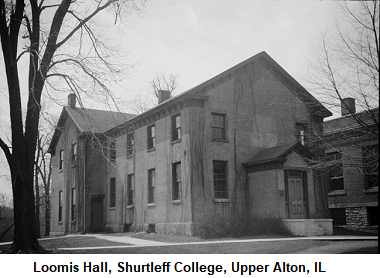 On
April 11, 1835, Peck left home at Rock Spring for the East once
again. He arrived at the capital on April 25. He preached among the
churches, and pleaded the cause of his Western institution. He
visited Dr. Shurtleff in Boston, and appealed for aid. Shurtleff
proposed giving $10,000 (which would be $341,863.64 in 2023,
according to the inflation calculator) for building purposes, if the
college would be renamed Shurtleff College, and a professorship of
rhetoric and elocution was formed. On October 9, Peck left New
England, and on November 18, he reached his home at Rock Spring and
found his family well. In January 1836, the charter of the seminary
was amended by changing the name of the Board to The Trustees of
Shurtleff College of Alton, Illinois.
On
April 11, 1835, Peck left home at Rock Spring for the East once
again. He arrived at the capital on April 25. He preached among the
churches, and pleaded the cause of his Western institution. He
visited Dr. Shurtleff in Boston, and appealed for aid. Shurtleff
proposed giving $10,000 (which would be $341,863.64 in 2023,
according to the inflation calculator) for building purposes, if the
college would be renamed Shurtleff College, and a professorship of
rhetoric and elocution was formed. On October 9, Peck left New
England, and on November 18, he reached his home at Rock Spring and
found his family well. In January 1836, the charter of the seminary
was amended by changing the name of the Board to The Trustees of
Shurtleff College of Alton, Illinois.
Between 1836 – 1841, the average number of students in attendance
was eighty-eight, with four instructors. The price for lodging at
the college in 1842 was from $1.50 to $1.75 per week. Food was an
additional $1.00 per week. The faculty in 1839 was Rev. Washington
Leverett, A. M., President and Professor of Moral Philosophy,
Mathematics and Natural Philosophy, Oratory, Rhetoric and Belles
Lettres, and Ancient Languages; Rev. Warren Leverett, A. M.,
Principal of the Preparatory Department; and Rev. Zenas B. Newman,
Assistant English and Classical Tutor.
On April 24, 1839, the trustees decided to erect a large building
that would serve the growing needs of the college for many years.
With the help of the experience of Dr. Peck, the four-story brick
building, containing 64 rooms, was erected. Mr. Zephaniah Lowe was
the contractor. In later years, hot water heating was added, which
replaced individual fireplaces or stoves. Bathrooms were added, and
the tall chimneys were removed. The old 8x10 glass in the windows
were replaced. An old bell, which used to swing over a popular
Mississippi River steamer, was hung on the building.
On June 13 1852, Peck mentioned in his diary of having his five
sons, with two of their wives and two grandchildren, at home and
surrounding the supper table together. They were five strong, hardy
men, from 21 – 38 years of age. On November 18, 1852, the original
Rock Spring Seminary building – where it all began – was destroyed
by fire. His son was working in the lower story and had a fire in
the fireplace. Leaving for a few moments, he returned and found the
wind had scattered fire among the combustibles around his workbench,
and the flames soon reached the ceiling above. John Peck’s
collection of files of papers, periodicals, and pamphlets, amounting
to several thousand volumes, were all destroyed. In January 1853, he
gathered his scattered and charred books - 1,500 volumes - into the
largest room in his house, which then became his library and study.
Peck resigned his duties on March 19, 1854, after receiving news
from his doctor that he had lung disease. He became frail as some
men at the age of 86. At the end of the year, he received news of
the death of his son, Harvey Jenks Peck, who died in Iowa on
December 17, 1854, a little over 41 years of age. For the remainder
of his life, Peck wrote in his diary and visited with friends,
including Cyrus Edwards of Upper Alton. On Sunday, March 14, 1858,
he passed away in his family home at Rock Spring, and was buried in
the Rock Springs Cemetery in O’Fallon. Twenty-nine days later, at
the special request of many friends and colleagues, his body was
disinterred and reburied in the Bellefontaine Cemetery in St. Louis,
to rest with other pioneer Baptist ministers.
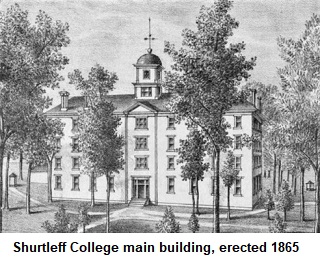
In about 1872, Shurtleff College was opened to young women. In later
years, the chapel, gymnasium, girl's dormitory, Martha Wood Cottage,
boarding hall, and the science annex were erected as demands were
met.
In June 1873, the Board of Trustees of Shurtleff College purchased
the private residence of Mr. Hiram N. Kendall for $20,000, for the
purpose of the women’s department.
In 1877, Doctor Benjamin Franklin Edwards passed away. His
connection to Shurtleff College dated back to 1827, when Rock Spring
Seminary was founded. Edwards served on the board of trustees for
the seminary from its beginning.
Carnegie Library
In 1907, wealthy businessman Andrew Carnegie gave $15,000 to
Shurtleff College for the purpose of building a library. The college
had to raise $15,000, in addition to Carnegie’s donation. Carnegie
had first objected to giving money to Shurtleff, as he heard that
too many students were educated for free, and he protested against
this, expressing his belief that students should pay for their
education. At last he was convinced to give, and the Carnegie
Library was erected.
Fire Destroys Original Main Building
The original main building, erected in 1865, was destroyed by fire
in 1938. It was replaced with a large, two-story, stone building in
1940, which still stands today.
Shurtleff College continued to grow and prosper throughout the years, ending its existence on June 30, 1957. The college reached its peak of enrollment in 1950, with 700 students. After its closure, the college because part of the Southern Illinois University system.
FACULTY OF ROCK SPRING SEMINARY - SHURTLEFF
COLLEGE
1829 (Rock Spring Seminary)
Principal – John Russell
Rev. John Mason Peck – Theology
John Messenger – Mathematics, etc.
1839 – Shurtleff College
Rev. Washington Leverett, A. M. – Mathematics, Natural Philosophy,
Oratory, Rhetoric, Fine Literature
Rev. Warren Leverett, A. M. – Preparatory Department
Rev. Zenas B. Newman – Assistant English and Classical Tutor
1849
Rev. Washington Leverett, A. M. – Mathematics and Natural Philosophy
Rev. Warren Leverett, A. M., Latin and Greek Languages
Erastus Adkins, A. M. – Oratory, Rhetoric, Fine Literature,
Chemistry, Mineralogy
Rev. Justus Bulkley, A. B. – Tutor and Principal of Preparatory
Dept.
William Cunningham, A. B. – Tutor and Principal of Preparatory Dept.
1869
Rev. Daniel Read, LL. D., President – Mental and Moral Science
Oscar Howes, A. M. – Latin and Greek Language, Literature
Charles Fairman, A. M. – Mathematics, Natural Philosophy
Orlando L. Castle, A. M. – Oratory, Rhetoric, Fine Literature
Ebenezer Marsh Jr., A. M. Ph.D – Chemistry, Geology, Mineralogy
Edward A. Haight, A. B. – Principal of Preparatory Department
Rev. Edward C. Mitchell, A. M. – biblical Literature and
Interpretation
Rev. Robert E. Pattison, D. D. – Systematic Theology, History of
Doctrine
Rev. Justus Bulkley, D. D. – Church History and Polity
1889
Rev. A. A. Kendrick, D. D., President – Systematic Theology
Orlando L. Castle, LL. D. – Oratory, Rhetoric, Fine Literature
Rev. Justus Bulkley, D. D. – Church History and Polity, Biblical
Literature and Interpretation
Charles Fairman, LL. D. – Mathematics and Natural Philosophy,
chemistry, Geology, Mineralogy
David G. Ray, A. M. – Latin and Greek Language, Literature
L. F. Schussler, M. D. – Physiology
1899
Austen Kennedy De Blois, PhD., LL. D., President – Psychology,
Ethics
Rev. Justus Bulkley, D. D., LL. D. – History
George Ernest Chipman, A. M., LL. B. – Political and Social Science
Samuel Ellis Swartz, PhD. – Natural Science
David George Ray, A. M. – Latin and Greek
Charles Hoben Day, A. M. – Modern Languages
Victor Leroy Duke, A. B. – Mathematics
David H. Jackson, B. L. – Physiology, Physical Culture
James Primrose Whyte, A. B. – English Literature, Oratory
Edward C. Lemen, A. M., M. D. – Medical Examiner
